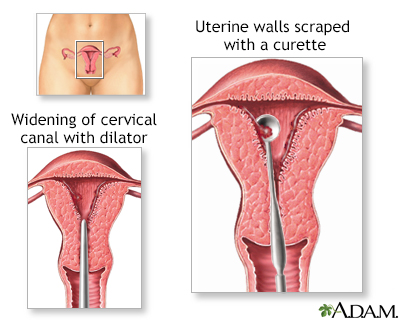
Dilation and curettage; Uterus scraping; Vaginal bleeding - dilation; Uterine bleeding - dilation; Menopause - dilation
D and C (dilation and curettage) is a procedure to scrape and collect the tissue (endometrium) from inside the uterus.


D and C, also called uterine scraping, may be performed in the hospital or in a clinic while you are under general or local anesthesia.
The health care provider will insert an instrument called a speculum into the vagina. This holds the vaginal canal open. Numbing medicine may be applied to the opening to the uterus (cervix).
The cervical canal is widened, and a curette (a metal loop on the end of a long, thin handle) is passed through the opening into the uterus cavity. The provider gently scrapes the inner layer of tissue, called the endometrium. Alternatively, a suction curette may be used to remove endometrial tissue. The tissue is collected for examination.
This procedure may be done to:
Your provider may also recommend a D and C if you have:
This list may not include all possible reasons for a D and C.
Risks related to D and C include:
Risks due to anesthesia include:
Risks of any surgery include:
The D and C procedure has few risks. It can provide relief from bleeding and can help diagnose cancer and other diseases.
You may return to your normal activities as soon as you feel better, possibly even the same day.
You may have vaginal bleeding, pelvic cramps, and back pain for a few days after the procedure. You can usually manage pain well with medicines. Avoid using tampons and having sexual intercourse for 1 to 2 weeks after the procedure.
Bulun SE. Physiology and pathology of the female reproductive axis. In: Melmed S, Auchus RJ, Goldfine AB, Koenig RJ, Rosen CJ, eds. Williams Textbook of Endocrinology. 14th ed. Philadelphia, PA: Elsevier; 2020:chap 17.
Ryntz T, Lobo RA. Abnormal uterine bleeding: etiology and management of acute and chronic excessive bleeding. In: Gershenson DM, Lentz GM, Valea FA, Lobo RA, eds. Comprehensive Gynecology. 8th ed. Philadelphia, PA: Elsevier; 2022:chap 26.
Williams VL, Thomas S. Dilation and curettage. In: Fowler GC, ed. Pfenninger and Fowler's Procedures for Primary Care. 4th ed. Philadelphia, PA: Elsevier; 2020:chap 162.
BACK TO TOPReview Date: 4/16/2024
Reviewed By: John D. Jacobson, MD, Professor Emeritus, Department of Obstetrics and Gynecology, Loma Linda University School of Medicine, Loma Linda, CA. Also reviewed by David C. Dugdale, MD, Medical Director, Brenda Conaway, Editorial Director, and the A.D.A.M. Editorial team.

|
A.D.A.M., Inc. is accredited by URAC, also known as the American Accreditation HealthCare Commission (www.urac.org). URAC's accreditation program is an independent audit to verify that A.D.A.M. follows rigorous standards of quality and accountability. A.D.A.M. is among the first to achieve this important distinction for online health information and services. Learn more about A.D.A.M.'s editorial policy, editorial process and privacy policy. A.D.A.M. is also a founding member of Hi-Ethics and subscribes to the principles of the Health on the Net Foundation (www.hon.ch). |
The information provided herein should not be used during any medical emergency or for the diagnosis or treatment of any medical condition. A licensed medical professional should be consulted for diagnosis and treatment of any and all medical conditions. Call 911 for all medical emergencies. Links to other sites are provided for information only -- they do not constitute endorsements of those other sites. © 1997- A.D.A.M., Inc. Any duplication or distribution of the information contained herein is strictly prohibited.